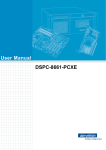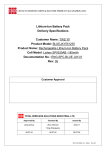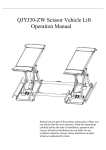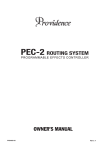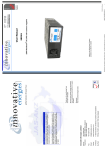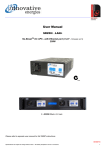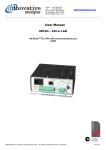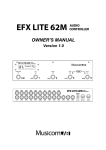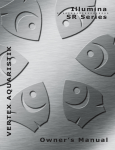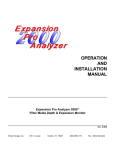Download WP Series Solar Charge Controller User`s Manual
Transcript
WP Series Solar Charge Controller User’s Manual Please read this manual carefully before using this product. Content 1. Safety attentions ....................................................................................................................................... 1 2. Introduction of WP series solar charge controller .................................................................................... 2 2.1 Product overview ................................................................................................................................. 2 2.2 Product features ................................................................................................................................... 2 3. Reference for system planning ............................................................................................................... 11 3.1 System voltage ................................................................................................................................... 11 3.2 Configuration of battery group .......................................................................................................... 12 3.3 Configuration of solar panels ............................................................................................................. 12 3.4 System wiring .................................................................................................................................... 13 3.5 System over-current protection .......................................................................................................... 14 3.6 System thunder stroke protection ....................................................................................................... 14 3.7 System grounding .............................................................................................................................. 14 4. Installation.............................................................................................................................................. 15 4.1 Dimension of the installing holes....................................................................................................... 15 4.2 System wiring diagram ...................................................................................................................... 16 4.3 Communication port .......................................................................................................................... 17 4.4 Installation procedure ........................................................................................................................ 17 5. Operation ............................................................................................................................................... 19 5.1 Instructions for LCD symbols ............................................................................................................ 19 5.2 Instructions for the function of buttons .............................................................................................. 22 5.3 LCD main interface loop ................................................................................................................... 23 5.4 View and set time and date ................................................................................................................ 25 5.5 View and set the battery type and communication port...................................................................... 25 5.6 View the controller related info.......................................................................................................... 27 5.7 View and set the charging controlling parameters.............................................................................. 28 5.8 View and set the load controlling parameters .................................................................................... 30 5.9 View generation data of solar panels.................................................................................................. 32 5.10 View the data of power consumed by load ....................................................................................... 33 5.11 View other statistic data ................................................................................................................... 34 5.12 Controlling parameters restore to factory default settings................................................................ 35 6. Troubleshooting ..................................................................................................................................... 36 6.1 Failure code meaning and trouble shooting ....................................................................................... 36 6.2 Common fault and handling............................................................................................................... 37 7. Specifications ......................................................................................................................................... 38 WP Series Solar Charge Controller User’s Manual V1.0 Dear customers: Thank you so much for trusting our company and selecting our products. Your solar power system will be guaranteed with reliable after-sales service! 1. Safety attentions (1)Please avoid exposure to flammable,explosive and corrosive liquids or gases, as well as dust in installation site. (2)Please protect the controller from direct sunlight or rain. (3)Please avoid any liquid spray and do not insert any foreign object to the controller. (4)The battery bank must be comprised of batteries of same type, make, and age. (5)Use the controller only for the charging of Gel, Sealed and flooded lead acid batteries. (6)It is not recommended to open or maintain the controller by yourself, without informing us or without any guidance from relevant professional. (7) After power on, please do not touch terminal blocks to avoid electric shock. (8)There are no fuses inside the controller, Install external fuses/breakers as required. (9) Check the wiring and connections at least once a year. 1 WP Series Solar Charge Controller User’s Manual V1.0 2. Introduction of WP series solar charge controller 2.1 Product overview WP series solar charge controller is a new series of intelligent, multi-purpose solar charge controllers. Its innovative structured design makes it easy to install and more reliable to use. Optimized charging and discharging management enables the service life of batteries to be greatly boosted. Meanwhile, more system symbols can be displayed in bigger LCD interface. Vivid symbols can show the working status of the system and relevant parameters can be fully displayed. What’s more, intelligent control of LED backlight makes it possible to see all symbols and parameters clearly even in the dim light conditions. Various control parameters can be flexibly set to fully meet your various application requirements. 2.2 Product features 1. 4-stage charging Bulk Charge stage: Bulk charge is the first stage in the charging process. In Bulk charging stage, the controller will deliver 100% of available solar power to recharge the battery and will trying to get the battery voltage up to the Absorb Voltage Setting. 2 WP Series Solar Charge Controller User’s Manual V1.0 Absorption Charge: When the battery voltage has recharged to the Absorption voltage setting, constant-voltage regulation is used to maintain battery voltage at the Absorption setpoint. This prevents heating and excessive battery gassing. The battery is allowed to come to full state of charge at the Absorption voltage setpoint. The absorb timer start to count and the controller stays in absorb until the Absorb Timer counts up to absorb time. Float Charge: After the battery is fully charged in the Absorption stage, the controller reduces the battery voltage to the Float voltage setpoint. When the battery is fully recharged, there can be no more chemical reactions and all the charging current is turned into heat and gassing. The float stage provides a very low rate of maintenance charging while reducing the heating and gassing of a fully charged battery. The purpose of float is to protect the battery from long-term overcharge. Once in float stage, loads can continue to draw power from the battery. In the event that the system load exceed the solar charge current, the controller will no longer be able to maintain the battery at the float setpoint. Should the battery voltage remain below the float setpoint for a cumulative 30 minute period, the controller will exit float stage and return to Bulk charging. 3 WP Series Solar Charge Controller User’s Manual V1.0 Equalizing Charge: Certain battery types benefit from a periodic boost charge to stir the electrolyte, balance the cell voltages, and complete the chemical reactions. Equalize charging raises the battery voltage above the standard absorption voltage so that the electrolyte gasses. Manual and auto equalizing charge function is available for this controller. The duration of the equalize charge can be set for user-defined battery type (USEr). Note: Before starting equalizing charge, please check whether your loads can work on the equalizing charge voltage. Please disconnect your loads first, if necessary. U 2h Equalizing Absorption Float Bulk 12.0V t Figure2-1 charge stage 4 WP Series Solar Charge Controller User’s Manual V1.0 2. Presets parameters for 3 different types of battery Standard charging parameters for “GEL”, “Sealed” and “Flooded” battery are preset. Moreover, a set of user-defined charging parameters are also available, and is shown as follows: Battery type Float voltage Absorb voltage Absorb time Equalize voltage Equalize time Equalize Interval GEL 13.7V 14.0V 2h --.- -- -- Sealed 13.7V 14.4V 2h 15.1V 2h 28days Flood 13.5V 14.6V 2h 15.4V 2h 28days User 13.7V 14.4V 2h 15.1V 2h 28days Note: If the battery type is “GEL”, “Sealed” or “Flooded”, above parameters are preset and you can’t set them. If the battery type is “GEL”, manual equalizing function and auto equalizing function are not available. 3. Auto-detect the battery voltage or locked to a fixed voltage. The “AUTO” setting allows the controller to detect the system voltage automatically on start up and the detected system voltage will never be changed during operation. The auto detect feature should only be used 5 WP Series Solar Charge Controller User’s Manual V1.0 in situations where the system voltage is unknown ahead of time or in systems where the system voltage may change periodically. 4. Adjustable charging voltage. When “User” battery type is selected, float voltage can be adjusted within certain range, default value is 13.7V (for 12V battery). Absorption voltage can be adjusted in a certain range, and the default value is 14.4V (for 12V battery). Equalizing voltage can also be adjusted in a certain range, and the default value is 15.1V (for 12V battery). 5. Temperature compensation for charging voltage. -4mV/Cell/℃ tem perature com pensation w ill be applied to the preset voltage for Float charge, Absorption charge and Equalizing charge according to the present battery voltage measured by the controller. For 12V battery, the compensation voltage U12 = (t-25)*6*(-0.004) V. You can deduce the other voltage level like this. 6. Real-time clock function. WP series controllers are designed with clock function, so the current year, month, day, hour, minute and 6 WP Series Solar Charge Controller User’s Manual V1.0 second can be showed. The internal clock keeps working when there is no battery, and no setting is needed when re-power the controller. Timing ON/OFF function for load is available, and the load can be set ON/OFF automatically for once each day. 7. Various control modes for load. There are five control modes for load. they are normal control mode(0), light control on and delayed off Mode(1), light control on and delayed off and one hour before dawn(2), light control mode(3) and Timing control mode(4). The delayed duration can be 1-24h. Following are the working introduction for each mode. event Load end of delay 1h before time set for time set for mode dark dawn time dawn on off 0 ------1 Load on Load off -Load off --2 Load on Load off Load on Load off --3 Load on --Load off --4 ----Load on Load off Note: The load will not be on if there is over-current, low voltage of battery or high voltage of battery. Load 7 WP Series Solar Charge Controller User’s Manual V1.0 will be shutdown under any circumstances like short-circuit, over-current, low or high voltage of battery. For normal controlling mode, load can only be turned on again when you turn on it by yourself. Load will recover to working normally after clearing the failures like battery low voltage protection, battery high voltage protection, load over-current protection and load short-circuit protection. For the mode 1, 2, 3 and 4, load will be turned on automatically when coming cross a load on event even the load have been turned off by person before. Load will be turned off automatically when coming cross a load off event even you have been turned on the load by person before. If the controller has any of the following situation like battery low voltage protection, battery high voltage protection, load over-current protection and load short-circuit protection, it will make a judgment for the turning on and off logic and then decide when to on or off the load. 8. Statistical data of generated energy and consumed energy. The controller will calculate the following data everyday: total generated power(kwh) ,total generated Ampere hours, Max generated power, Max generated voltage from the solar panel daily, total used power (kwh) ,total used Ampere hours by load, Max power used by load daily, lowest battery voltage and highest battery voltage, etc. Data will be updated to the display interface after dawn. That is to say, the data you see during the daytime is a reflection of yesterday. 8 WP Series Solar Charge Controller User’s Manual V1.0 9. Communication function. This is an optional function. If you need this function, please let us know before your order is placed. You can view all the relevant data through computer’s COM port and the parameters like float charge voltage, low disconnect voltage, low reconnect voltage and time for auto turn on and turn off the load (in timing mode) can be set. There are other functions like turning on/off the load by remote control and unlock the protection. RS232 or RS485 bus is provided. The communication ID range is from 1-99. Communication mode can be either passive or active. In active mode, the interval for transmitting data can be set from 1S-250S. For more information about communication protocol, please contact us or consult our dealers. 10. Protection for reversed connection of battery. If the battery is connected with controller in reversed polarity (not connected with solar panel), controller will not be damaged and will work as normal when correctly connected. 11. Protection for reversed connection of solar panel. If the solar panels is connected with controller in reversed polarity, controller will not be damaged and will work as normal when correctly connected. 12. Protection for reverse-discharge of battery. 9 WP Series Solar Charge Controller User’s Manual WP series controllers are able to protect battery from reversed discharging to solar panel at night. V1.0 13. Overheat protection. Once the internal temperature is detected to be higher than a certain value by the controller, it will stop charging the battery and then recharging the battery automatically after the temperature drop to a certain value. 14. Protection for input over-current from solar panel. Controller will stop charging when excess current is detected from the solar panel, and repower automatically after 2minutes. 15. Over-current protection for load. The load will be turned off when the output current of the load exceeds its rated current for a while, and then be turned on automatically after 20 minutes. 16. Short circuit protection for load. Controller will enter protection state when the load is detected to be short circuit, and repower automatically after 2 minutes. 10 WP Series Solar Charge Controller User’s Manual V1.0 17. Under-voltage protection for battery. Controller will turn off the load when the battery voltage is lower than the value preset for under-voltage protection, and turn on the load when the battery voltage reaches the value preset for under-voltage reconnect. The value for under-voltage protection and under-voltage reconnect can be set by users in a certain range. 18. Over-voltage protection for battery. Controller will turn off the load when the battery voltage is higher than the value preset for over-voltage protection, and turn on the load when the battery voltage is 1V lower than the value preset for over-voltage protection. 3. Reference for system planning 3.1 System voltage 12V, 24V, 48V are three common voltage type for DC solar power system, and the higher voltage type is, the larger power could be used. Users have to select voltage type according to the power of the load, the work voltage range of the load and some other factors. The table on right is the power range of advice for three kinds of voltage type. 11 System voltage 12V Power range <800W 24V <2000W 48V <6000W WP Series Solar Charge Controller User’s Manual V1.0 3.2 Configuration of battery group The voltage of battery group should be same as the system voltage. The capacity of battery group is decided by the power of load, daily duration of the load and the spare time for rainy days. In any of the following condition, the bigger battery group is required: 1. the power of load is higher, 2. the load is used longer per day, 3. more time is spared for rainy days. 3.3 Configuration of solar panels Power of solar panels is decided by load power, using time of load one day and sunshine condition. The generated power of solar panels every day should be exceeding the power used by the load and have some reserve. For 12V system, we suggest you to choose a type of solar panel that its Voc is around 22V. If necessary, parallel more panels. The maximum Voc should not exceed 50V for 12V system. For 24V system, we suggest you to choose a type of solar panel that its Voc is around 44V and parallel some if necessary. Maximum Voc should not exceed 50V for 24V system. For 48V system, choose solar panels with Voc around 44V and make 2pcs in series and then parallel some, maximum Voc of series panels should not exceed 100V. 12 WP Series Solar Charge Controller User’s Manual V1.0 3.4 System wiring Cables are supposed to be selected according to the system current, system voltage, temperature rise allowed, voltage drop allowed and the material of the cables (copper cable or aluminum cable). It is recommended that the loop voltage loss of the battery to be controlled within 2%, and the loop voltage loss of the solar panel to be controlled within 2.5%. Distance in meters(feet) Wire Size(mm2) 30A 40A 50A 60A 9# AWG(6.6mm2) 1.5m(5.0) ---2 8# AWG(8.3mm ) 1.9m(6.3) 1.4m(4.7) --7# AWG(10.5mm2) 2.4m(7.9) 1.8m(5.9) 1.4m(4.7) -6# AWG(13.3mm2) 3.0m(10) 2.3m(7.5) 1.8m(6.0) 1.5m(5.0) 2 5# AWG(16.7mm ) 3.8m(12.6) 2.9m(9.4) 2.3m(7.5) 1.9m(6.3) 4# AWG(21.1mm2) --2.9m(9.5) 2.4m(7.9) 3# AWG(26.6mm2) --3.7m(12.0) 3.0m(10) copper cable, 2% voltage drop, maximum 1-way wire distance for 12 Volt 13 WP Series Solar Charge Controller User’s Manual V1.0 3.5 System over-current protection The over-current fusing protection device should be set up for all electronic equipment which is applied to power equipment and WP series controllers are no exception. Design for sharing anode is applied in WP controllers, users are recommended to install over-current fusing protection device in solar cathode loop, and in the cathode loop of battery. And the capacity of the over current fusing protection device should be at least 1.25 times of the rated current. 3.6 System thunder stroke protection Like many other electronic devices, WP series controllers may be damaged by thunder stroke. The surge arrester function of controller is limited and users are recommended to install devices for surge arrester on the input side to enhance system reliability. 3.7 System grounding Due to the design of sharing anode scheme, the positive pole, the negative pole of individual solar panel or the negative pole of individual battery can be connected to the ground. But the negative pole of individual solar panel or the negative pole of individual battery can never be connected to the ground at the same time. 14 WP Series Solar Charge Controller User’s Manual 4. Installation 4.1 Dimension of the installing holes 15 V1.0 WP Series Solar Charge Controller User’s Manual 4.2 System wiring diagram 16 V1.0 WP Series Solar Charge Controller User’s Manual V1.0 4.3 Communication port The hardware interface we used is RJ11-4P4C, as clearly shown in the picture below. One communication cable will be provided for controllers with remote communication function. The pins of RS232 and RS485 are different, below detailed function of different pins for your reference. pins 1 2 3 4 functions RS232 RS485 GND GND NC NC RX(controller) A(+) TX(controller) B(-) 4.4 Installation procedure Note: Please disconnect battery and solar panels before installing controllers. Do not touch the positive and negative terminals of the solar panels or the battery at the same time. Otherwise, you may be danger with electric shock. A.Install the controller on a fixed vertical plane and fasten the screws. 10cm should be reserved from all sides to ensure good heat dissipation performance. B.Check if the voltage of the battery and the solar panels is within the prescribed range. C.Disconnect the over-current fusing protection device or breaker in the loop of battery and solar module. D.Connect the cables of load, battery and solar module with the load terminals, battery terminals and 17 WP Series Solar Charge Controller User’s Manual V1.0 terminals for solar module respectively and then fasten them. E.Insert the temperature sensor into the corresponding port, if the remote communication function is available , please also connect the communication cable with the controller. F.Connect the battery circuit first to see whether the LCD interface is displaying, if the LCD interface is failed to displaying, please handle this problem according to chapter 6.2. Besides, the load will be turned on when the controller is powered on, and you can go further if your load works normally G.Then connect the circuit of solar module. If it is daytime, the controller will start to charge the battery and you can check the present charging current and the voltage of solar panels. Note: In order to prevent water flowing into the controller along the cables of solar panel, please make a U-shaped bending for the cables of solar panel before connecting with solar controller. Distance between battery and controller should not be too long, otherwise, charge and discharge control accuracy may affected by the dropout voltage between the terminals of battery and the terminals of controller. 18 WP Series Solar Charge Controller User’s Manual 5. Operation 5.1 Instructions for LCD symbols V1.0 symbol meaning Controller detected solar panels voltage and judge that now is daytime Controller haven’t detected solar panels voltage and judge that now is night time Solar panels flicker slowly, controller haven’t detected solar panels voltage within 24 hours Charging circuit is connected, but charging current less than 0.1A Charging current more than 0.1A Battery fully charged, charging circuit is automatically disconnect Flashing quickly means solar panels charging current too large and controller under over current protection state Battery capacity percentage, 20% for each cell Battery voltage in normal state Flicker quickly means battery high voltage protection Flicker slowly means battery low voltage protection 19 WP Series Solar Charge Controller User’s Manual symbol V1.0 meaning Load is turned off by protection action or load off action. Under normal controlling mode (mode 0),if this symbol is not display means that the loads is turned off by user. Controller supplying power to load, but load current less than 0.1A Load current more than 0.1A. Current setting of battery type is GEL. Current setting of battery type is Sealed. Current setting of battery type is Flooded. Not showing any of the battery type means that battery is customized type The current data relates to battery temperature The current data relates to charging The current data relates to discharging The current data relates to communication. Present interface is secondary interface. The data in present secondary interface can’t be set. 20 WP Series Solar Charge Controller User’s Manual symbol meaning Current setting data is float charging voltage At interface 2 of main loop, means battery at float charging stage Current data is absorption voltage setting At interface 2 of main loop, means battery at absorption stage Current data is equalization charging setting At interface 2 of main loop, means battery at equalization charging stage The current data is low voltage protection data The current data is low voltage reconnect data Load controlling mode is one of mode 0 to 3 Load controlling mode is mode 4(timing ON/OFF) Flicker quickly means load under short circuit protection state Flicker quickly means load under over-current protection state 21 V1.0 WP Series Solar Charge Controller User’s Manual V1.0 5.2 Instructions for the function of buttons Buttons Operation Functions circulate the menu clockwise in the main loop interface and the secondary loop interface , quit the modification for the parameters and exit the short press parameter set state. long press short press enter into secondary loop interface at the main loop. enter into parameter set state in secondary loop. save the modified parameters and exit the parameter set state. circulate the menu anti-clockwise in the main loop interface and the secondary loop interface, increase the value in the parameter set state. increase the value automatically in the parameter set state. long press short press on and off the load at main loop interface. decrease the value in the parameter set state. exit to the main loop interface in the secondary loop interface. decrease the value automatically in the parameter set state. long press 22 WP Series Solar Charge Controller User’s Manual V1.0 5.3 LCD main interface loop LCD main loop includes 8 interfaces. They are respectively current time, battery voltage, environment temperature, generating current of solar panels, consuming current of the loads, generating power of solar panels, consuming power of loads, failure code (not showing this interface when there is no failure). Circulate the interfaces by short press Menu button or Plus button. It will revert to the main interface if there is no failure and there is no operation on the buttons in 50s. It will skip to failure code display interface if there is failure. It will revert to the main loop interface 1 automatically without saving the setting data if there is no operation on the button in 50s. At the main interface 1 to 7, long press Menu will enter into different secondary interface loop. At secondary interface loop use Menu or Plus to circulate the interface the same as main loop. At secondary interface (not set state)short press Minus to revert to the main loop. on the top right corner. If this parameter can After entering into secondary interface loop, it will show on the top right corner. At secondary interface loop, long press Menu to not be changed, it will show enter into parameter set state, and the parameter will start flashing. Long press Menu in the parameter set state to save the setting(except saving seconds data). Short ress Menu will exit the set state without saving. Long press Plus or Minus will increase or decrease the value automatically in parameter set state. Long press Menu and Plus (more than 3 seconds) same time at main loop interface 1 will enter into view 23 WP Series Solar Charge Controller User’s Manual V1.0 other statistics data loop. Long press Menu and Plus (more than 3 seconds) same time at main loop interface 2 will enter into controlling parameters restore to factory default setting interface. 24 WP Series Solar Charge Controller User’s Manual V1.0 5.4 View and set time and date At the main loop interface1 long press Menu to enter into secondary Loop1. View and revise the time info at this interface loop. Long press Menu and the corresponding parameter starts flashing, press Minus or Plus to revise time or date. Long press Menu to save the setting and exit the setting state (Short press Menu to save the data of seconds). Short press Menu in month setting state, it will switch between the month and date. Short ress Menu at hour setting state, it will switch between the hour and minute. Short ress Menu at year setting interface will exit the setting state without saving the set data. 5.5 View and set the battery type and communication port At main loop interface2 long Press Menu to enter into secondary Loop2. View and change the battery type, battery voltage detection method, controller communication serial number and controller communicating mode. After saving the data of the battery type and battery voltage detection method, controller will re-start automatically to renew the controlling data. 25 WP Series Solar Charge Controller User’s Manual V1.0 It is built with the charging controlling data for GEL battery, Sealed battery and Flooded battery. It has the reserve for customized charging controller parameter—USEr. The Charging parameter can only be revised when the battery type is customized type (USEr). Charging parameter cannot be revised for other battery types. (Loop2 interface1) Battery detection method has 12V/24V auto, or fixed at 12V, 24V or 48V. Different controller has different voltage scope for auto switch. (Loop2 interface2) Controller communication serial number setting interface and controller communication mode are only available when the controller is equipped with communication function. Controller communication serial number can be set from 1~99 and the default is 1(Loop2 interface3). Controller communication mode has 2 types, active mode and passive mode. 0 means passive communicating mode. Controller will sending the data after receiving order. 1~250 means active communicating mode, controller will send the charging and discharging data every 1~250 seconds. 26 WP Series Solar Charge Controller User’s Manual V1.0 5.6 View the controller related info At the main loop interface3, long press Menu to enter into secondary Loop3. The following info are available: controller rated voltage, rated charging current, rated discharging current, present controller internal temperature, present solar panels array voltage, controller firmware version and controller serial number. 27 WP Series Solar Charge Controller User’s Manual V1.0 5.7 View and set the charging controlling parameters At the main loop interface4 long press Menu to enter into secondary interface Loop4. View and set the floated voltage, absorption charging voltage and absorption charging time and equalization related setting(when the battery is GEL battery, interface4~9 will not be showed). Interface 4 is main switch of equalization charge setting. If this setting is OFF, controller will not do equalization charging and interface 5~9 will not show. It will be OFF state if the controller has been power on. Interface 7 is the setting interface for equalization mode. It has AUTO and OFF. AUTO means controller will do the equalization charging for the battery 1 time for the setting of interval days. OFF means controller will not do equalization charging. Interface 8 means the interval days for auto equalization. It can be set from 10~99 days. Interface 9 is the interface for manual equalization controlling. In any state (except GEL battery type), switch it to ON will start one equalization charge stage. Switch it to OFF, will stop the current equalization charging and change into float charging state. 28 WP Series Solar Charge Controller User’s Manual 29 V1.0 WP Series Solar Charge Controller User’s Manual V1.0 5.8 View and set the load controlling parameters At main loop interface5, long press Menu to enter into secondary interface Loop5. The following parameters can be viewed and set: low voltage protection point, low voltage reconnect point and load controlling mode. Load controlling mode has 5 kinds, see the following chart: Code load controlling mode 0 normal controller mode(mode 0) 1 light control load on and time-delay off (mode 1) 2 light control load on and time-delay off , 1 hour before dawn load will be turn on(mode 2) 3 light control load on and light control load off(mode 3) 4 Load on and load off at a set time(mode 4) Load controlling mode decides whether interface 4 ~ interface 7 can be showed If controlling mode is 0, interface 4~7 will not be showed. If controlling mode is 1, interface 6~7 will not be showed If controlling mode is 2, interface 6~7 will not be showed If controlling mode is 3, interface 4, interface 6 and interface 7 will not be showed. If controlling mode is 4, interface 4 and interface 5 will not be showed. 30 WP Series Solar Charge Controller User’s Manual V1.0 Interface 4 is the hours that the load will work at night in mode 1 and mode 2. Interface5 is the threshold voltage of light controlling for load mode 1, mode 2 and mode 3. If the solar panels voltage is less than this point, the controller judge that now is nighttime and the load will be turn on after 30 seconds. If the value is higher than this point 1V (for 12V system, for other system, multiple it), the controller judge that now is daytime and turn off the load after 30 seconds. Interface 6 is the time for turning on the load in mode 4. Hours and minutes can be set. Interface 7 is the time for turning off the load in mode 4. Hours and minutes can be set. 31 WP Series Solar Charge Controller User’s Manual V1.0 5.9 View generation data of solar panels At main loop interface 6, long press Menu to enter into secondary interface Loop6. The following info can be viewed from this interface: accumulated power data generated by solar panels of yesterday. maximum generating power by solar panels of yesterday, maximum voltage of solar panels for yesterday, solar panels accumulated generating power and current. The accumulated generating power and current can be cleared. 32 WP Series Solar Charge Controller User’s Manual V1.0 5.10 View the data of power consumed by load At the main loop interface 7, long press Menu to enter into secondary interface loop 7. The following info can be viewed: the energy consumed by load yesterday, maximum consumed power loads yesterday, minimum voltage of battery yesterday, maximum voltage of battery yesterday, accumulated consuming kwh data and Ah data by load. The accumulated kwh data and Ah data can be cleared by user. 33 WP Series Solar Charge Controller User’s Manual V1.0 5.11 View other statistic data At main loop interface 8, long press Menu and Plus together to enter into secondary Loop8. In this loop, the following data can be viewed: the extreme condition for controlling to work, the maximum current generated by solar panels, maximum current consumed by load, maximum voltage for solar panels, maximum voltage of battery, maximum value for environment temperature, minimum value for environment temperature, the working days of controller after connected, the accumulative number of low voltage protection. 34 WP Series Solar Charge Controller User’s Manual V1.0 5.12 Controlling parameters restore to factory default settings At main loop interface 2,long press Menu and Plus together to enter into secondary interface Loop9. The default value can be recovered at this interface. At loop9 interface1 long press Menu till the symbols in the dotted column starts flashing, then the controlling parameters will recover to the default value. Controller will re-start automatically to renew the controlling data. 35 WP Series Solar Charge Controller User’s Manual 6. Troubleshooting 6.1 Failure code meaning and trouble shooting Error the cause of failure code voltage too low, E01 battery controller has turned off the load E02 the load output is over-current, controller has turned off the load E03 E04 E05 E07 load output is short-circuit, the controller has turned off the load battery voltage too high, controller has turned off the load V1.0 trouble shooting Use AC charger to charge the battery or change a fully charged battery. Decrease the load, use Minus button to turn on the load or the load will be automatically turn on by the controller after 20min. Remove the short-circuit failure of load, use Minus button to turn on the load. Check whether the battery connecting cable is loose, check whether the battery capacity is too small, check whether there is another charger connected with the battery. It can be recovered to charging automatically after the temperature has been decreased. The controller stops charging the battery, because the controller internal overheating. The output current of solar panels Check whether the power of solar panel has been overpower, exceeds rated current so that the decrease the parallel quantity of solar panels and then the controller stop to charging. controller can be start to charging automatically after 2mins. 36 WP Series Solar Charge Controller User’s Manual 6.2 Common fault and handling V1.0 Common fault handling No display on LCD interface after finished the system connection Check whether the switch of the battery circuit is turned on and fuse protector of battery circuit has been installed and make sure the polarity of connection wire was right. No charging current after finished system connection Check whether the polarity of solar panels is right. Make sure the connection of wire is complete and no disconnection condition. No working with load after finished the system connection Check whether you have connected the load with right polarity and whether the controller has over-load, low-voltage or overvoltage protection. No display of battery’s temperature Check whether you have plug the temperature sensor in. The load can not be on/off at fixed time preset. Check whether the load mode has been setting as 4 and Check whether the voltage of battery is too low. The load can’t be turned on automatically at night when the load has been setting with light control Check whether the load mode has been correctly set and Check whether the solar panels has been shined by other light source. 37 WP Series Solar Charge Controller User’s Manual 7. Specifications Model Solar Input Battery V1.0 WP3024Z WP3048 Input voltage ≤50V ≤100V Rated input current 30A 30A Charge loop voltage drop ≤0.2V ≤0.35V System voltage 12V/24V Auto 48V No load loss ≤13mA(Backlight off) ≤18mA(Backlight off) Battery type Sealed, GEL, Flooded, User Charging mode 4 stage(Bulk, Absorption, Float, Equalizing), PWM Float voltage 13.7V(13V~15V)×1/×2/×4 Absorption voltage 14.4V(13V~15V)×1/×2/×4 Equalizing voltage 15.1V(13V~15.5V)×1/×2/×4 Temperature compensation -4mV/Cell/℃ 38 WP Series Solar Charge Controller User’s Manual Load Related V1.0 Rated load current 30A 30A Discharge loop drop ≤0.10V ≤0.12V Low voltage disconnect 10.7V(10V~14V)×1/×2/×4 Low voltage reconnect 12.6V(10V~14V)×1/×2/×4 Overvoltage disconnect 16.5V×1/×2/×4(reconnect ,1V lower) Man-machine interface LCD with white backlight, 3 red silica gel buttons Max wire size 16mm2 (AWG 5#) Working temperature -20℃ ~ +55℃ Storage temperature -30℃ ~ +80℃ Working humidity 10% ~ 90%, no condensation Dimension 187 mm x 98.5 mm x 49.5 mm Weight 400 g Case Protection IP30 39 420g










































